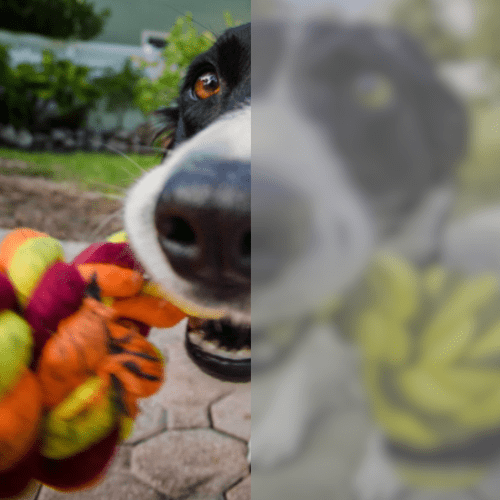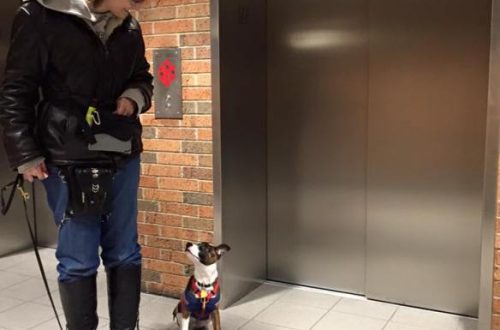
Is it true that dogs can’t see colors?
In what colors do dogs see the world around them? For a long time it was believed that they could only see in black and white, but science has proven that this is not the case. But what colors can pets see, how many colors can they see, and why can’t they see the way we do? Read on to learn all about the vision of dogs and how they perceive the world.
Contents
Dogs can’t see colors?
While the widely held theory in the past that dogs see everything in black and white has proven to be false, the truth is that they see in roughly the same range of colors as people with red-green color blindness, according to the American Kennel Club ( AKS). If the eyes of people with normal vision contain three types of color receptors called cones that perceive the entire spectrum of visible light, then people with red-green color blindness have only two types of cones, which makes them incapable of perceiving red and green colors.
There are only two types of cones in the retina of a dog’s eye. This means that dogs are unable to perceive not only red and green colors, but also shades containing any of these colors, such as pink, purple and orange. Dogs also cannot perceive subtle changes in brightness or color tone. That is, they see differently than a person.
What colors can dogs see?
Dogs can distinguish shades of yellow, blue, and brown, as well as various shades of grey, black, and white. This means that if your dog has a red toy, it will appear brown, while an orange toy, which is a mixture of red and yellow, will appear brownish yellow. It also means that if you want to fully engage your pet’s senses while playing, you should choose toys that are blue or yellow so that they stand out against the duller shades of brown and gray in your dog’s field of vision. This explains why animals love bright yellow tennis balls so much.
The theory of black and white vision
If dogs can see certain colors, where did the idea come from that they only see black and white? Such a performance, the AKC reports, can be attributed to National Dog Week founder Will Judy, who wrote in a 1937 training manual that it was likely that dogs can only see in shades of black and gray. In the 1960s, scientists perpetuated this myth by incorrectly assuming that primates were the only animals that could distinguish colors. A similar idea of the vision of dogs persisted until recently, until in 2013, Russian researchers questioned the “color blindness” of animals. After that, they proved that dogs can see and distinguish between yellow and blue, according to the Smithsonian Institution.
The researchers conducted an experiment to see if dogs could distinguish between these two colors or contrasting degrees of brightness. It consisted of the following: four sheets of paper – light yellow, dark yellow, light blue and dark blue – were glued to boxes of food, and only in a box with dark yellow paper was a piece of meat. Once the dogs learned to associate the dark yellow paper with their treat, the scientists glued only the dark blue and light yellow paper to the boxes, suggesting that if the dogs tried to open the box with the blue paper, it would be because they associated the dark color with the food. shade, not color. But most of the subjects walked directly to the yellow paper, demonstrating that they had learned to associate color, not brightness, with food.
The absence of color receptors is not the only thing that distinguishes a dog’s vision from that of a human. Pets are very short-sighted, their vision is estimated at approximately -2,0 – -2,5, according to Business Insider. This means that when a dog looks at something six meters away, it seems to him that it is at a distance of 22,3 meters.
And while you might think that your dog has poor eyesight, the AKC notes that not only do animals have a wider field of vision than humans because of their wide-set eyes, they also see fast movements better, allowing them to easily spot fast-moving prey.
Your dog’s other senses
But don’t be in a hurry to get upset that your dog sees the world in muted colors: what he lacks in vision, he more than makes up for with his other senses. First, according to DogHealth.com, dogs can hear a much wider range of frequencies than humans, including sounds that are so high that human ears simply can’t pick them up.
But the dog’s hearing is only second in acuity after the sense of smell. Sense of smell of dogs at least at least 10 times (if not more) stronger than in humans, according to NOVA PBS. A dog’s nose contains up to 000 million olfactory receptors, while humans have only about six million.
Moreover, the part of the animal brain responsible for smell analysis is forty times larger than that of a human. All this means is that your dog can “see” pictures with his nose that are much brighter than we can imagine. What it lacks in poor eyesight and color perception, it more than makes up for in information derived solely from smells.
See what your dog sees
While we don’t have any way to smell the way his dog does, today you can get an idea of what her world looks like with an online app. The Dog Vision app allows you to upload a photo and, after adjusting the colors and focus, see how it will look for your pet. This is a useful tool for those people who have ever thought about how they look in the eyes of their dog or how dogs see the world in general.
The next time you look into your puppy’s expressive eyes, don’t be discouraged that he doesn’t see you as clearly as you see him. Your special scent tells your dog more than just a look, and he will recognize your scent anywhere, whether he sees you or not.





